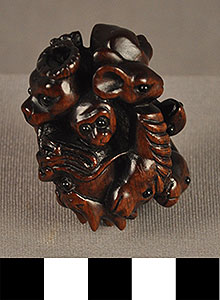| Description |
8/30/2013: "A rare miniature Japanese wood okimono of the Junishi (Twelve Animals of the Zodiac), carved vertically, with openwork, in the round. Each animal with inlaid jet eyes, late Meiji period, 1 3/4”h x 1 1/2” dia. the Junishi is based upon the lunar calendar which is traditionally employed in the Far East. The twelve years of the duodenary cycle are symbolized by animals. It is believed that a person born in the year presided over by one of these animals bears it characteristics.
The Zodiac calendar was introduced from China. The development of the Japanese Zodiac is based on astronomy which was popularized during the Han Dynasty (206 BCE - 220 AD). By incorporating astronomy into the planets, sun, birth date, birth Time, and Zodiac sign. The 12 animal signs of the Zodiac are each associated to a year and each aligned with the orbit of Jupiter around the sun. Jupiter has an orbital period of 11.85920 yr. Chinese astronomer rounded that value to 12 years and divided the Zodiac wheel into 12 sections representing 12 animals. There are many legends about how the 12 animal signs were selected to be forever embodied in the Zodiac symbol. One legend talks about the Jade Emperor, who was associated with Daoism and was the ruler of Heaven. He requested his servant, the rat, to plan a banquet and invite the remaining 11 animals. There is supposed to be a cat involved, but the cunning and intelligent rat tricked the cat into thinking the banquet was the following day. The cat misses the banquet and the Jade Emperor does not honor it by granting a place on the Zodiac. From that day forth the cat vows to remain the enemy of the rat. Another legend that comes from Buddhism states that Bodhidharma asked all the animals of the world to come wish him well before he ascended into the heavens as a God. On that day only 12 animals came and Bodhidharma displayed his gratitude for their day only 12 animals came and Bodhidharma displayed his gratitude for their commitment and assigned a year to each of the animals in the order in which they arrived.
The animals did not become part of the Zodiac cycle until late in the Chinese Tang Dynasty (618 AD - 907 AD). Others assert that the animal symbols came about as early as the Qin dynasty (221 BC - 206 BC) when information was exchanged by Indian Buddhist pilgrims on the Silk Route from India. During this time Japan adopted a great deal from Chinese culture and the Chinese Zodiac was used as a calendar. It was not until Buddhism was officially introduced to Japan in 552 AD that the Japanese adopted the Zodiac wheel. The Zodiac calendar was given a new name of Kunshi and the 12 animal symbols from the Zodiac were called Junishi.
Unlike the western Zodiac which comprises 12 star signs for the 12 months of the year, the Japanese Zodiac works by calculating the years which repeats every 12 years. Each year is named after a specific animal. A person’s Zodiac symbol is dependent on the year they were born.
The Zodiac’s popularity in Japan peaked during the Edo Era (1615-1868 AD), by which time each of the 12 animals were commonly associated with one of eight Buddhist patron protector deities (four guarding the four cardinal directions and four guarding the four semi-directions; the latter four are each associated with two animals, thus covering all 12 animals).
Since the 18th century the Zodiac animals have been popular themes in Japanese decorative arts. Their kanji written names and/or cyclical dates have been frequently found in Japanese decorative arts for dating purposes. In order to facilitate the readings of the Japanese Zodiac calendar, the Japanese created/invented their very own Zodiac symbols using 12 animals. The names of the 12 Animals of the Zodiac are written in kanji.
Rat Nezumi
Ox Ushi
Tiger Tora
Hare Usagi
Dragon Tatsu
Snake Hebi
Horse Uma
Goat Hitsuji
Monkey Saru
Rooster Tori
Dog Inu
Boar Inoshishi" - Bernie Mcmanus, Appraiser, Woodbury House, 8/8/2013
|
